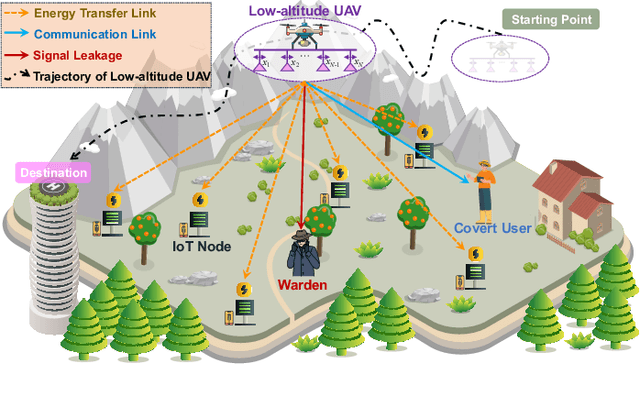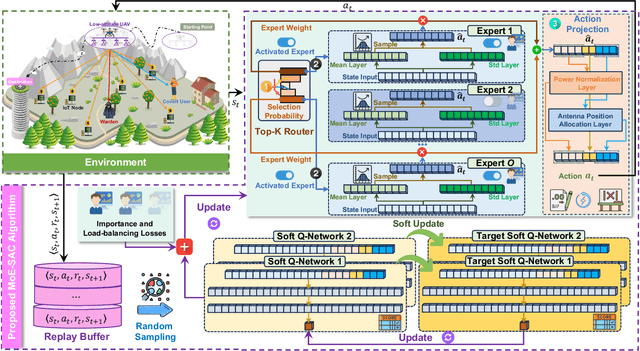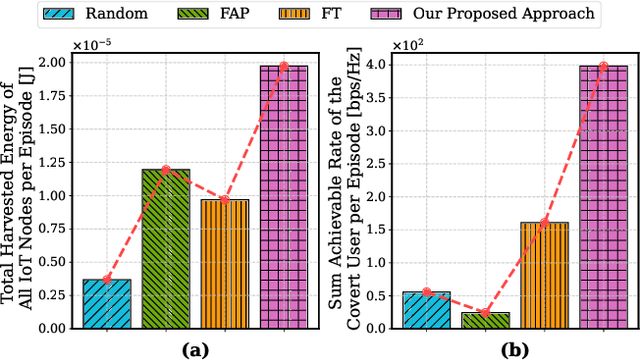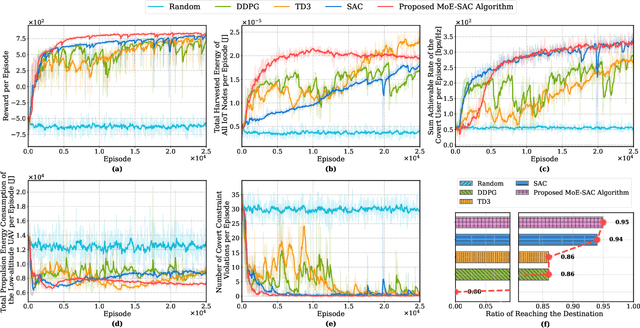Dusit Niyato
Sherman
Joint Visible Light and Backscatter Communications for Proximity-Based Indoor Asset Tracking Enabled by Energy-Neutral Devices
Oct 31, 2025Abstract:In next-generation wireless systems, providing location-based mobile computing services for energy-neutral devices has become a crucial objective for the provision of sustainable Internet of Things (IoT). Visible light positioning (VLP) has gained great research attention as a complementary method to radio frequency (RF) solutions since it can leverage ubiquitous lighting infrastructure. However, conventional VLP receivers often rely on photodetectors or cameras that are power-hungry, complex, and expensive. To address this challenge, we propose a hybrid indoor asset tracking system that integrates visible light communication (VLC) and backscatter communication (BC) within a simultaneous lightwave information and power transfer (SLIPT) framework. We design a low-complexity and energy-neutral IoT node, namely backscatter device (BD) which harvests energy from light-emitting diode (LED) access points, and then modulates and reflects ambient RF carriers to indicate its location within particular VLC cells. We present a multi-cell VLC deployment with frequency division multiplexing (FDM) method that mitigates interference among LED access points by assigning them distinct frequency pairs based on a four-color map scheduling principle. We develop a lightweight particle filter (PF) tracking algorithm at an edge RF reader, where the fusion of proximity reports and the received backscatter signal strength are employed to track the BD. Experimental results show that this approach achieves the positioning error of 0.318 m at 50th percentile and 0.634 m at 90th percentile, while avoiding the use of complex photodetectors and active RF synthesizing components at the energy-neutral IoT node. By demonstrating robust performance in multiple indoor trajectories, the proposed solution enables scalable, cost-effective, and energy-neutral indoor tracking for pervasive and edge-assisted IoT applications.
Low-Altitude UAV-Carried Movable Antenna for Joint Wireless Power Transfer and Covert Communications
Oct 30, 2025



Abstract:The proliferation of Internet of Things (IoT) networks has created an urgent need for sustainable energy solutions, particularly for the battery-constrained spatially distributed IoT nodes. While low-altitude uncrewed aerial vehicles (UAVs) employed with wireless power transfer (WPT) capabilities offer a promising solution, the line-of-sight channels that facilitate efficient energy delivery also expose sensitive operational data to adversaries. This paper proposes a novel low-altitude UAV-carried movable antenna-enhanced transmission system joint WPT and covert communications, which simultaneously performs energy supplements to IoT nodes and establishes transmission links with a covert user by leveraging wireless energy signals as a natural cover. Then, we formulate a multi-objective optimization problem that jointly maximizes the total harvested energy of IoT nodes and sum achievable rate of the covert user, while minimizing the propulsion energy consumption of the low-altitude UAV. To address the non-convex and temporally coupled optimization problem, we propose a mixture-of-experts-augmented soft actor-critic (MoE-SAC) algorithm that employs a sparse Top-K gated mixture-of-shallow-experts architecture to represent multimodal policy distributions arising from the conflicting optimization objectives. We also incorporate an action projection module that explicitly enforces per-time-slot power budget constraints and antenna position constraints. Simulation results demonstrate that the proposed approach significantly outperforms some baseline approaches and other state-of-the-art deep reinforcement learning algorithms.
Virtual-Real Collaborated Split Learning via Model Partitioning in IRS-Assisted IoT Networks
Oct 30, 2025Abstract:This paper investigates a novel computation and communication co-design framework for large-scale split learning in intelligent reflecting surface (IRS)-assisted internet of things (IoT) networks integrated with digital twin (DT) technique. The considered system consists of a multi-antenna access point (AP), multiple heterogeneous user devices (UDs), and an deployed IRS to enhance both uplink and downlink transmission. The training process of a deep neural network is partitioned between devices and the AP, where a DT replica is activated to replace UDs with insufficient local computation capabilities. We formulate a delay-optimal split learning problem, which optimizes five key variables: layer partitioning points, DT assignment decisions, IRS phase shift matrix, AP downlink power allocation, and DT frequency adjustment, aiming to minimize the overall end-to-end delay under communication and computation. The proposed optimization problem is a highly coupled non-convex mixed-integer problem. Therefore, we solve using an alternating optimization approach combining closed-form updates, semidefinite relaxation (SDR), and low-complexity heuristics. Extensive simulations demonstrate that the proposed scheme significantly reduces training delay compared to conventional baselines and achieves up to 35\% delay improvement, especially under high UD density and stringent power constraints.
Edge Collaborative Gaussian Splatting with Integrated Rendering and Communication
Oct 26, 2025Abstract:Gaussian splatting (GS) struggles with degraded rendering quality on low-cost devices. To address this issue, we present edge collaborative GS (ECO-GS), where each user can switch between a local small GS model to guarantee timeliness and a remote large GS model to guarantee fidelity. However, deciding how to engage the large GS model is nontrivial, due to the interdependency between rendering requirements and resource conditions. To this end, we propose integrated rendering and communication (IRAC), which jointly optimizes collaboration status (i.e., deciding whether to engage large GS) and edge power allocation (i.e., enabling remote rendering) under communication constraints across different users by minimizing a newly-derived GS switching function. Despite the nonconvexity of the problem, we propose an efficient penalty majorization minimization (PMM) algorithm to obtain the critical point solution. Furthermore, we develop an imitation learning optimization (ILO) algorithm, which reduces the computational time by over 100x compared to PMM. Experiments demonstrate the superiority of PMM and the real-time execution capability of ILO.
Cost Minimization for Space-Air-Ground Integrated Multi-Access Edge Computing Systems
Oct 24, 2025Abstract:Space-air-ground integrated multi-access edge computing (SAGIN-MEC) provides a promising solution for the rapidly developing low-altitude economy (LAE) to deliver flexible and wide-area computing services. However, fully realizing the potential of SAGIN-MEC in the LAE presents significant challenges, including coordinating decisions across heterogeneous nodes with different roles, modeling complex factors such as mobility and network variability, and handling real-time decision-making under partially observable environment with hybrid variables. To address these challenges, we first present a hierarchical SAGIN-MEC architecture that enables the coordination between user devices (UDs), uncrewed aerial vehicles (UAVs), and satellites. Then, we formulate a UD cost minimization optimization problem (UCMOP) to minimize the UD cost by jointly optimizing the task offloading ratio, UAV trajectory planning, computing resource allocation, and UD association. We show that the UCMOP is an NP-hard problem. To overcome this challenge, we propose a multi-agent deep deterministic policy gradient (MADDPG)-convex optimization and coalitional game (MADDPG-COCG) algorithm. Specifically, we employ the MADDPG algorithm to optimize the continuous temporal decisions for heterogeneous nodes in the partially observable SAGIN-MEC system. Moreover, we propose a convex optimization and coalitional game (COCG) method to enhance the conventional MADDPG by deterministically handling the hybrid and varying-dimensional decisions. Simulation results demonstrate that the proposed MADDPG-COCG algorithm significantly enhances the user-centric performances in terms of the aggregated UD cost, task completion delay, and UD energy consumption, with a slight increase in UAV energy consumption, compared to the benchmark algorithms. Moreover, the MADDPG-COCG algorithm shows superior convergence stability and scalability.
LMM-Incentive: Large Multimodal Model-based Incentive Design for User-Generated Content in Web 3.0
Oct 06, 2025Abstract:Web 3.0 represents the next generation of the Internet, which is widely recognized as a decentralized ecosystem that focuses on value expression and data ownership. By leveraging blockchain and artificial intelligence technologies, Web 3.0 offers unprecedented opportunities for users to create, own, and monetize their content, thereby enabling User-Generated Content (UGC) to an entirely new level. However, some self-interested users may exploit the limitations of content curation mechanisms and generate low-quality content with less effort, obtaining platform rewards under information asymmetry. Such behavior can undermine Web 3.0 performance. To this end, we propose \textit{LMM-Incentive}, a novel Large Multimodal Model (LMM)-based incentive mechanism for UGC in Web 3.0. Specifically, we propose an LMM-based contract-theoretic model to motivate users to generate high-quality UGC, thereby mitigating the adverse selection problem from information asymmetry. To alleviate potential moral hazards after contract selection, we leverage LMM agents to evaluate UGC quality, which is the primary component of the contract, utilizing prompt engineering techniques to improve the evaluation performance of LMM agents. Recognizing that traditional contract design methods cannot effectively adapt to the dynamic environment of Web 3.0, we develop an improved Mixture of Experts (MoE)-based Proximal Policy Optimization (PPO) algorithm for optimal contract design. Simulation results demonstrate the superiority of the proposed MoE-based PPO algorithm over representative benchmarks in the context of contract design. Finally, we deploy the designed contract within an Ethereum smart contract framework, further validating the effectiveness of the proposed scheme.
Joint AoI and Handover Optimization in Space-Air-Ground Integrated Network
Sep 16, 2025Abstract:Despite the widespread deployment of terrestrial networks, providing reliable communication services to remote areas and maintaining connectivity during emergencies remains challenging. Low Earth orbit (LEO) satellite constellations offer promising solutions with their global coverage capabilities and reduced latency, yet struggle with intermittent coverage and limited communication windows due to orbital dynamics. This paper introduces an age of information (AoI)-aware space-air-ground integrated network (SAGIN) architecture that leverages a high-altitude platform (HAP) as intelligent relay between the LEO satellites and ground terminals. Our three-layer design employs hybrid free-space optical (FSO) links for high-capacity satellite-to-HAP communication and reliable radio frequency (RF) links for HAP-to-ground transmission, and thus addressing the temporal discontinuity in LEO satellite coverage while serving diverse user priorities. Specifically, we formulate a joint optimization problem to simultaneously minimize the AoI and satellite handover frequency through optimal transmit power distribution and satellite selection decisions. This highly dynamic, non-convex problem with time-coupled constraints presents significant computational challenges for traditional approaches. To address these difficulties, we propose a novel diffusion model (DM)-enhanced dueling double deep Q-network with action decomposition and state transformer encoder (DD3QN-AS) algorithm that incorporates transformer-based temporal feature extraction and employs a DM-based latent prompt generative module to refine state-action representations through conditional denoising. Simulation results highlight the superior performance of the proposed approach compared with policy-based methods and some other deep reinforcement learning (DRL) benchmarks.
Trust Semantics Distillation for Collaborator Selection via Memory-Augmented Agentic AI
Sep 09, 2025Abstract:Accurate trustworthiness evaluation of potential collaborating devices is essential for the effective execution of complex computing tasks. This evaluation process involves collecting diverse trust-related data from potential collaborators, including historical performance and available resources, for collaborator selection. However, when each task owner independently assesses all collaborators' trustworthiness, frequent data exchange, complex reasoning, and dynamic situation changes can result in significant overhead and deteriorated trust evaluation. To overcome these challenges, we propose a task-specific trust semantics distillation (2TSD) model based on a large AI model (LAM)-driven teacher-student agent architecture. The teacher agent is deployed on a server with powerful computational capabilities and an augmented memory module dedicated to multidimensional trust-related data collection, task-specific trust semantics extraction, and task-collaborator matching analysis. Upon receiving task-specific requests from device-side student agents, the teacher agent transfers the trust semantics of potential collaborators to the student agents, enabling rapid and accurate collaborator selection. Experimental results demonstrate that the proposed 2TSD model can reduce collaborator evaluation time, decrease device resource consumption, and improve the accuracy of collaborator selection.
SemSteDiff: Generative Diffusion Model-based Coverless Semantic Steganography Communication
Sep 05, 2025Abstract:Semantic communication (SemCom), as a novel paradigm for future communication systems, has recently attracted much attention due to its superiority in communication efficiency. However, similar to traditional communication, it also suffers from eavesdropping threats. Intelligent eavesdroppers could launch advanced semantic analysis techniques to infer secret semantic information. Therefore, some researchers have designed Semantic Steganography Communication (SemSteCom) scheme to confuse semantic eavesdroppers. However, the state-of-the-art SemSteCom schemes for image transmission rely on the pre-selected cover image, which limits the universality. To address this issue, we propose a Generative Diffusion Model-based Coverless Semantic Steganography Communication (SemSteDiff) scheme to hide secret images into generated stego images. The semantic related private and public keys enable legitimate receiver to decode secret images correctly while the eavesdropper without completely true key-pairs fail to obtain them. Simulation results demonstrate the effectiveness of the plug-and-play design in different Joint Source-Channel Coding (JSCC) frameworks. The comparison results under different eavesdroppers' threats show that, when Signal-to-Noise Ratio (SNR) = 0 dB, the peak signal-to-noise ratio (PSNR) of the legitimate receiver is 4.14 dB higher than that of the eavesdropper.
Rotatable Antenna Aided Mixed Near-Field and Far-Field Communications in the Upper Mid-Band: Interference Analysis and Joint Optimization
Sep 05, 2025Abstract:In this paper, we propose to leverage rotatable antennas (RAs) for improving the communication performance in mixed near-field and far-field communication systems by exploiting a new spatial degree-of-freedom (DoF) offered by antenna rotation to mitigate complex near-field interference and mixed-field interference. Specifically, we investigate a modular RA-enabled mixed-field downlink communication system, where a base station (BS) consisting of multiple RA subarrays communicates with multiple near-field users in the presence of several legacy far-field users. We formulate an optimization problem to maximize the sum-rate of the near-field users by jointly optimizing the power allocation and rotation angles of all subarrays at the BS. To gain useful insights into the effect of RAs on mixed-field communications, we first analyze a special case where all subarrays share the same rotation angle and obtain closed-form expressions for the rotation-aware normalized near-field interference and the rotation-aware normalized mixed-field interference using the Fresnel integrals. We then analytically reveal that array rotation effectively suppresses both interference types, thereby significantly enhancing mixed-field communication performance. For the general case involving subarray-wise rotation, we propose an efficient double-layer algorithm to obtain a high-quality solution, where the inner layer optimizes power allocation using the successive convex approximation (SCA) technique, while the outer layer determines the rotation angles of all subarrays via particle swarm optimization (PSO). Finally, numerical results highlight the significant performance gains achieved by RAs over conventional fixed-antenna systems and demonstrate the effectiveness of our developed joint design compared to benchmark schemes.
 Add to Chrome
Add to Chrome Add to Firefox
Add to Firefox Add to Edge
Add to Edge